1. Giannoudis PV, Giannoudi M, Stavlas P. Damage control orthopaedics: lessons learned. Injury. 2009; 40(Suppl 4):S47–S52. PMID:
19895952.

2. Roberts CS, Pape HC, Jones AL, Malkani AL, Rodriguez JL, Giannoudis PV. Damage control orthopaedics: evolving concepts in the treatment of patients who have sustained orthopaedic trauma. Instr Course Lect. 2005; 54:447–462. PMID:
15948472.
3. Kreder HJ. Principles and evidence: The optimal treatment of pertrochanteric hip fractures: Commentary on an article by Kjell Matre, MD, et al.: “TRIGEN INTERTAN intramedullary nail versus sliding hip screw. A prospective, randomized multicenter study on pain, function, and complications in 684 patients with an intertrochanteric or subtrochanteric fracture and one year of follow-up”. J Bone Joint Surg Am. 2013; 95:e16(1-2). PMID:
23389796.
4. Miedel R, Törnkvist H, Ponzer S, Söderqvist A, Tidermark J. Musculoskeletal function and quality of life in elderly patients after a subtrochanteric femoral fracture treated with a cephalomedullary nail. J Orthop Trauma. 2011; 25:208–213. PMID:
21399469.

5. Cheng MT, Chiu FY, Chuang TY, Chen CM, Chen TH, Lee PC. Treatment of complex subtrochanteric fracture with the long gamma AP locking nail: a prospective evaluation of 64 cases. J Trauma. 2005; 58:304–311. PMID:
15706192.

6. Kregor PJ, Stannard J, Zlowodzki M, Cole PA, Alonso J. Distal femoral fracture fixation utilizing the Less Invasive Stabilization System (LISS): the technique and early results. Injury. 2001; 32(Suppl 3):SC32–SC47. PMID:
11888193.

7. Corrales LA, Morshed S, Bhandari M, Miclau T 3rd. Variability in the assessment of fracture-healing in orthopaedic trauma studies. J Bone Joint Surg Am. 2008; 90:1862–1868. PMID:
18762645.

8. Waddell JP. Subtrochanteric fractures of the femur: a review of 130 patients. J Trauma. 1979; 19:582–592. PMID:
469971.
9. Parker MJ, Dutta BK, Sivaji C, Pryor GA. Subtrochanteric fractures of the femur. Injury. 1997; 28:91–95. PMID:
9205572.

10. Fielding JW, Cochran GV, Zickel RE. Biomechanical characteristics and surgical management of subtrochanteric fractures. Orthop Clin North Am. 1974; 5:629–650. PMID:
4600224.

11. Seinsheimer F. Subtrochanteric fractures of the femur. J Bone Joint Surg Am. 1978; 60:300–306. PMID:
649632.

12. Zickel RE. An intramedullary fixation device for the proximal part of the femur. Nine years' experience. J Bone Joint Surg Am. 1976; 58:866–872. PMID:
956232.

13. Johnson KD, Tencer AF, Sherman MC. Biomechanical factors affecting fracture stability and femoral bursting in closed intramedullary nailing of femoral shaft fractures, with illustrative case presentations. J Orthop Trauma. 1987; 1:1–11. PMID:
3506582.

14. Kraemer WJ, Hearn TC, Powell JN, Mahomed N. Fixation of segmental subtrochanteric fractures. A biomechanical study. Clin Orthop Relat Res. 1996; (332):71–79.
15. Brumback RJ, Toal TR Jr, Murphy-Zane MS, Novak VP, Belkoff SM. Immediate weight-bearing after treatment of a comminuted fracture of the femoral shaft with a statically locked intramedullary nail. J Bone Joint Surg Am. 1999; 81:1538–1544. PMID:
10565645.

16. Yoon RS, Donegan DJ, Liporace FA. Reducing subtrochanteric femur fractures: tips and tricks, do's and don'ts. J Orthop Trauma. 2015; 29(Suppl 4):S28–S33.
17. Bone LB, Giannoudis P. Femoral shaft fracture fixation and chest injury after polytrauma. J Bone Joint Surg Am. 2011; 93:311–317. PMID:
21266645.

18. Bosse MJ, MacKenzie EJ, Riemer BL, et al. Adult respiratory distress syndrome, pneumonia, and mortality following thoracic injury and a femoral fracture treated either with intramedullary nailing with reaming or with a plate. A comparative study. J Bone Joint Surg Am. 1997; 79:799–809. PMID:
9199375.

19. Stavlas P, Giannoudis PV. Bilateral femoral fractures: does intramedullary nailing increase systemic complications and mortality rates. Injury. 2009; 40:1125–1128. PMID:
19775688.

20. Asher MA, Tippett JW, Rockwood CA, Zilber S. Compression fixation of subtrochanteric fractures. Clin Orthop Relat Res. 1976; (117):202–208.

21. Yoo MC, Cho YJ, Kim KI, Khairuddin M, Chun YS. Treatment of unstable peritrochanteric femoral fractures using a 95 degrees angled blade plate. J Orthop Trauma. 2005; 19:687–692. PMID:
16314715.
22. Celebi L, Can M, Muratli HH, Yagmurlu MF, Yuksel HY, Bicimoğlu A. Indirect reduction and biological internal fixation of comminuted subtrochanteric fractures of the femur. Injury. 2006; 37:740–750. PMID:
16487528.

23. Vaidya SV, Dholakia DB, Chatterjee A. The use of a dynamic condylar screw and biological reduction techniques for subtrochanteric femur fracture. Injury. 2003; 34:123–128. PMID:
12565019.

24. Dumbre Patil SS, Karkamkar SS, Patil VS, Patil SS, Ranaware AS. Reverse distal femoral locking compression plate a salvage option in nonunion of proximal femoral fractures. Indian J Orthop. 2016; 50:374–378. PMID:
27512218.
25. Oh CW, Kim JJ, Byun YS, et al. Minimally invasive plate osteosynthesis of subtrochanteric femur fractures with a locking plate: a prospective series of 20 fractures. Arch Orthop Trauma Surg. 2009; 129:1659–1665. PMID:
19169695.

26. Papanna MC, Al-Hadithy N, Ma CH, Tu YK, Yu SW, Yen CY, Yeh JH, Wu CH. Reverse LISS plates for unstable proximal femoral fractures [Injury 2010;41(8):827-33]. Injury. 2012; 43:392.
27. Ma CH, Tu YK, Yu SW, Yen CY, Yeh JH, Wu CH. Reverse LISS plates for unstable proximal femoral fractures. Injury. 2010; 41:827–833. PMID:
20471014.

28. Acklin YP, Bereiter H, Sommer C. Reversed LISS-DF in selected cases of complex proximal femur fractures. Injury. 2010; 41:427–429. PMID:
19555949.

29. Crist BD, Khalafi A, Hazelwood SJ, Lee MA. A biomechanical comparison of locked plate fixation with percutaneous insertion capability versus the angled blade plate in a subtrochanteric fracture gap model. J Orthop Trauma. 2009; 23:622–627. PMID:
19897982.

30. Wieser K, Babst R. Fixation failure of the LCP proximal femoral plate 4.5/5.0 in patients with missing posteromedial support in unstable per-, inter-, and subtrochanteric fractures of the proximal femur. Arch Orthop Trauma Surg. 2010; 130:1281–1287. PMID:
20191276.
31. Pape HC, van Griensven M, Rice J, et al. Major secondary surgery in blunt trauma patients and perioperative cytokine liberation: determination of the clinical relevance of biochemical markers. J Trauma. 2001; 50:989–1000. PMID:
11426112.


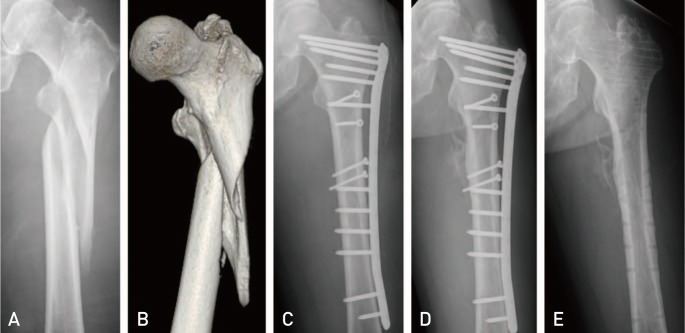
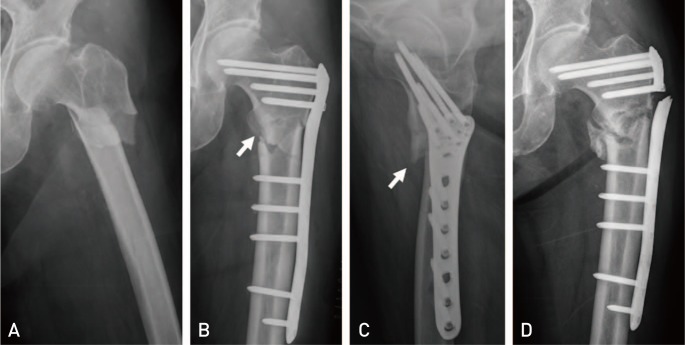




 PDF
PDF ePub
ePub Citation
Citation Print
Print


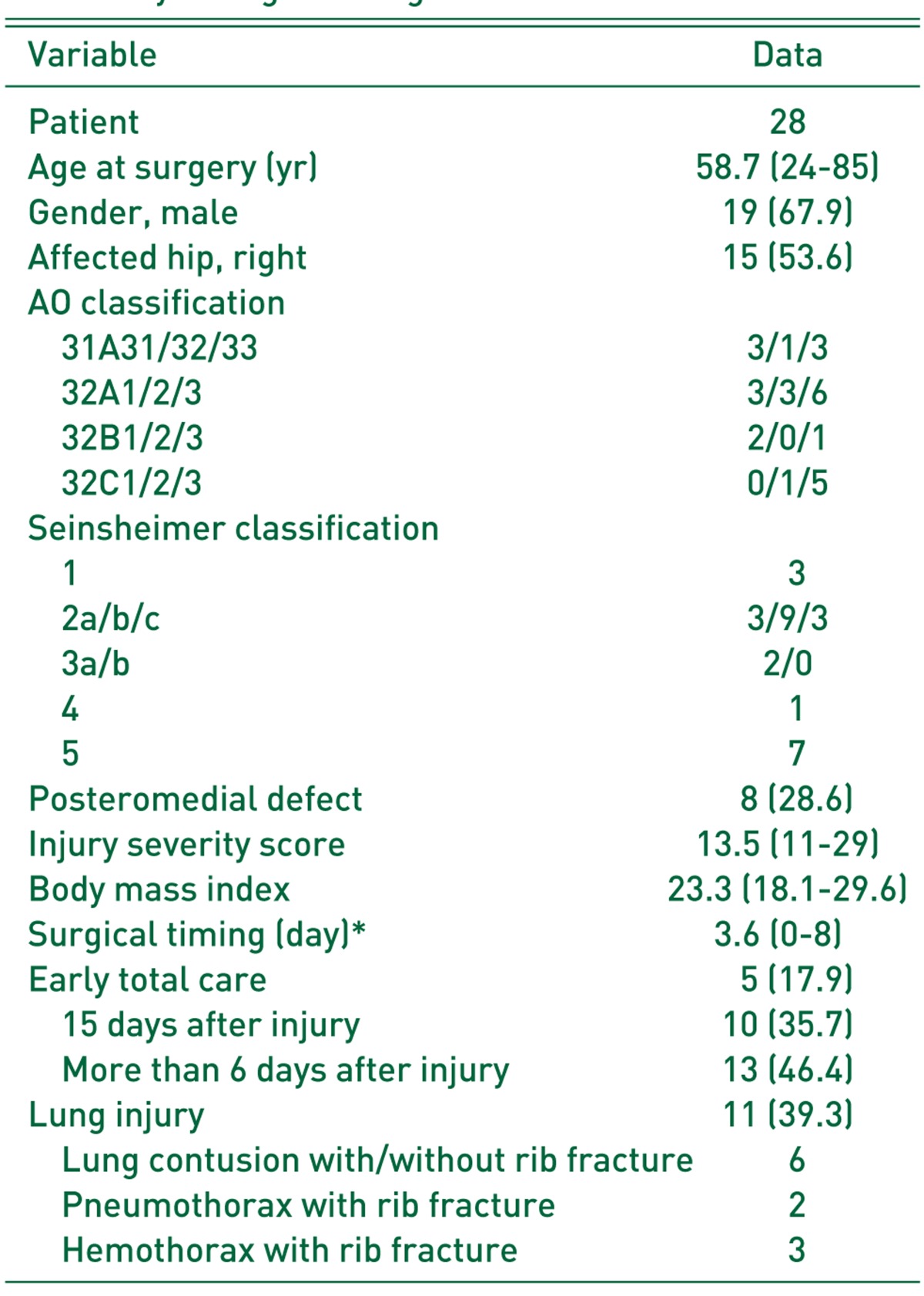
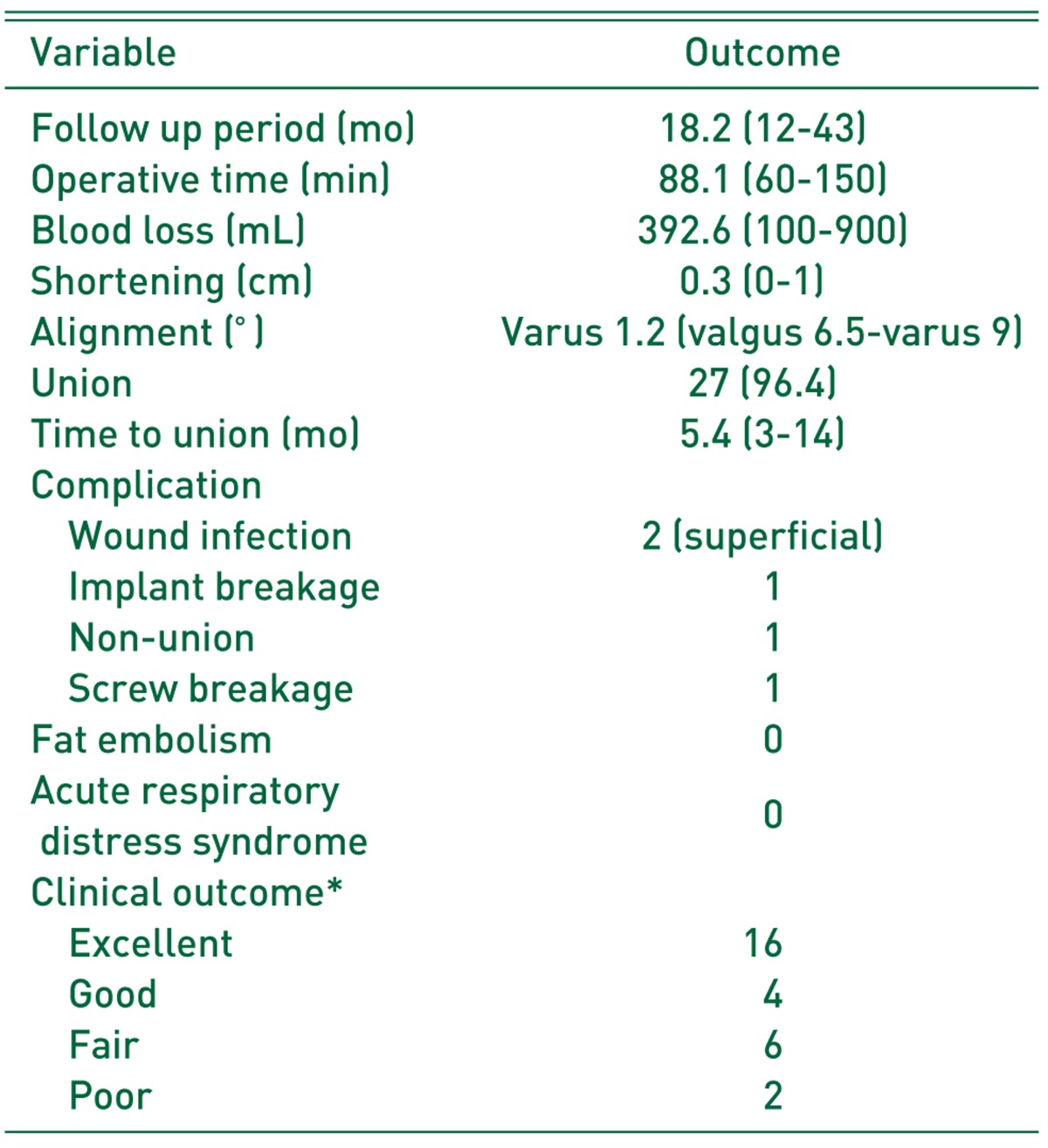
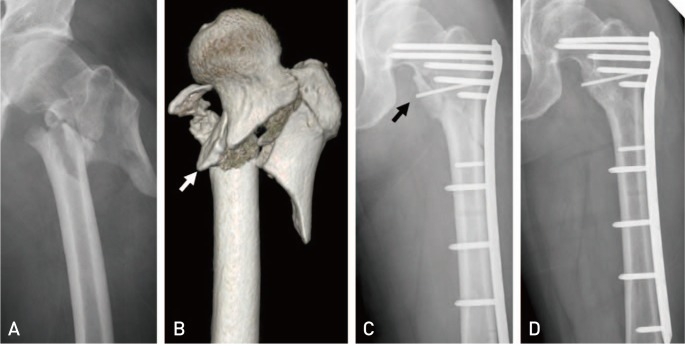
 XML Download
XML Download